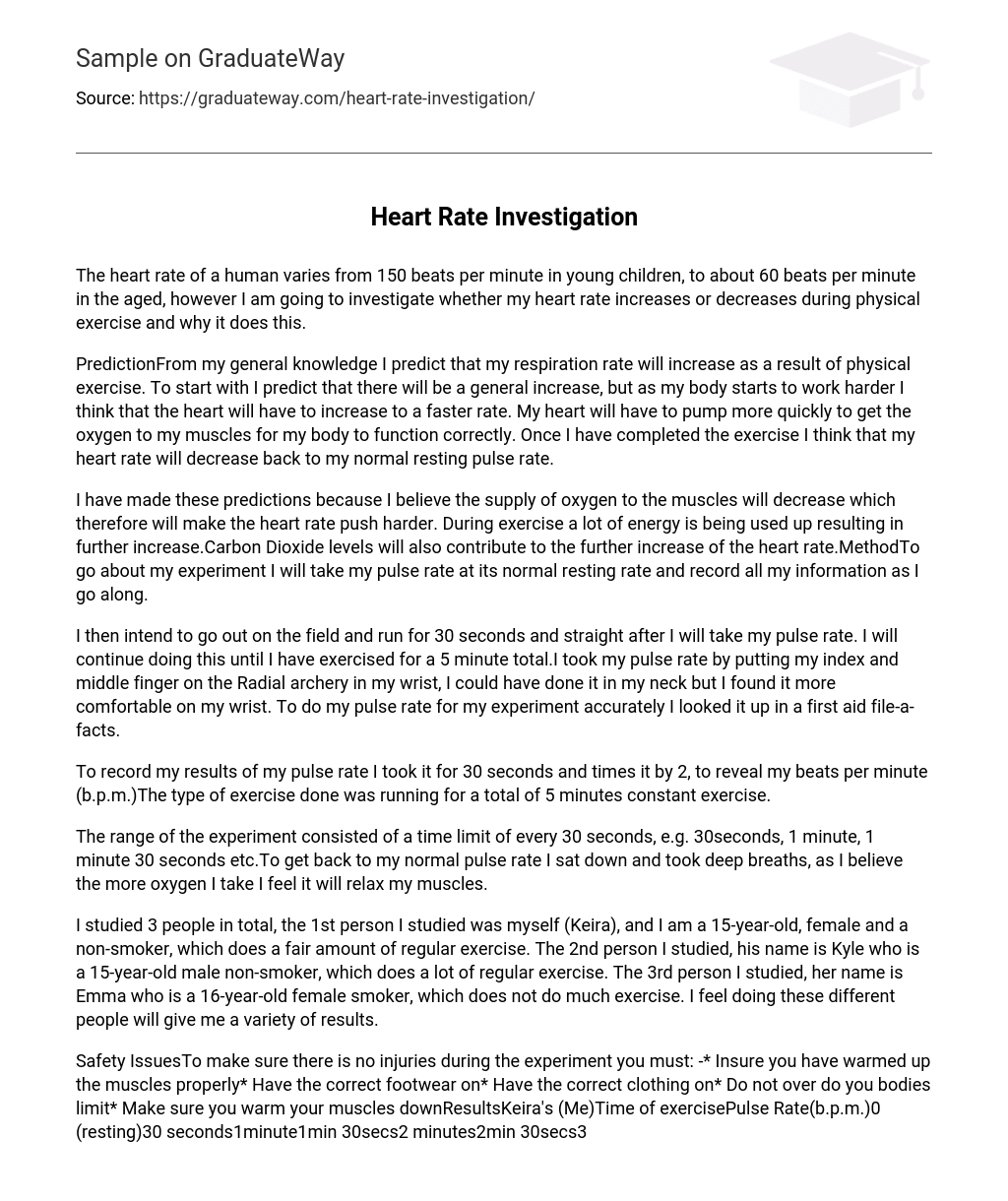The heart rate of a human varies from 150 beats per minute in young children, to about 60 beats per minute in the aged, however I am going to investigate whether my heart rate increases or decreases during physical exercise and why it does this.
PredictionFrom my general knowledge I predict that my respiration rate will increase as a result of physical exercise. To start with I predict that there will be a general increase, but as my body starts to work harder I think that the heart will have to increase to a faster rate. My heart will have to pump more quickly to get the oxygen to my muscles for my body to function correctly. Once I have completed the exercise I think that my heart rate will decrease back to my normal resting pulse rate.
I have made these predictions because I believe the supply of oxygen to the muscles will decrease which therefore will make the heart rate push harder. During exercise a lot of energy is being used up resulting in further increase.Carbon Dioxide levels will also contribute to the further increase of the heart rate.MethodTo go about my experiment I will take my pulse rate at its normal resting rate and record all my information as I go along.
I then intend to go out on the field and run for 30 seconds and straight after I will take my pulse rate. I will continue doing this until I have exercised for a 5 minute total.I took my pulse rate by putting my index and middle finger on the Radial archery in my wrist, I could have done it in my neck but I found it more comfortable on my wrist. To do my pulse rate for my experiment accurately I looked it up in a first aid file-a-facts.
To record my results of my pulse rate I took it for 30 seconds and times it by 2, to reveal my beats per minute (b.p.m.)The type of exercise done was running for a total of 5 minutes constant exercise.
The range of the experiment consisted of a time limit of every 30 seconds, e.g. 30seconds, 1 minute, 1 minute 30 seconds etc.To get back to my normal pulse rate I sat down and took deep breaths, as I believe the more oxygen I take I feel it will relax my muscles.
I studied 3 people in total, the 1st person I studied was myself (Keira), and I am a 15-year-old, female and a non-smoker, which does a fair amount of regular exercise. The 2nd person I studied, his name is Kyle who is a 15-year-old male non-smoker, which does a lot of regular exercise. The 3rd person I studied, her name is Emma who is a 16-year-old female smoker, which does not do much exercise. I feel doing these different people will give me a variety of results.
Safety IssuesTo make sure there is no injuries during the experiment you must: -* Insure you have warmed up the muscles properly* Have the correct footwear on* Have the correct clothing on* Do not over do you bodies limit* Make sure you warm your muscles downResultsKeira’s (Me)Time of exercisePulse Rate(b.p.m.)0 (resting)30 seconds1minute1min 30secs2 minutes2min 30secs3 minutes3mins 30secs4 minutes4mins 30secs5 minutes7489101114156179196205214222235Average162Kyle’sTime of exercisePulse Rate (b.
p.m.)0 (resting)30 seconds1minute1min 30secs2 minutes2min 30secs3 minutes3mins 30secs4 minutes4mins 30secs5 minutes70788898104125150169187199217Average135AnalysisMy graphs shows that the pulse rates started on a steady level then increase through out my investigation to a maximum of 235 beats per minute on Keira’s graph after 5minutes of exercise of running and jogging from a resting rate of 74 beats per minute. After 1 minute of psychical exercise, my heart rate increased to 101 b.
p.m, which is a difference of 27 b.p.m from my resting rate.
I took my pule rate for a further 2,3,4 and 5 minutes but my pulse rate is still fairly high with 21 b.p.m from the previous minute of 214 b.p.
m.The reasons for this increase are that the muscles have a demand for oxygen, which is carried in the hemoglobin that is formed in the red blood cells. Oxygen is picked up from the alveoli in the lungs, which cause people to breathe heavily when exercising. The glucose in the food we eat is also transported around the body in our blood.
During respiration our bodies use glucose and oxygen to make energy to enable our muscles to work, the waste products such as Carbon Dioxide and water are taken away from our bodies by our blood.The people I studied were roughly the same age but of different fitness levels, different sex’s and also one of them smokes. It only shows slightly in my results but if I took more care into concentrating on the pulse rate maybe it would have shown more dramatically.EvaluationIn my personal opinion I thought my results was fairly ok but maybe a little too high to what they should have been.
I did not find any difficulties in taking the pulse rate, it was just being able to keep count as it was going fast and difficult to make sure I didn’t loose the pulse.You can’t be sure that you do the same exercise every time as peoples styles of running may vary, also different people run at different paces and speed. To improve this situation it may be better to try running up and down the stairs so many times in a minute.I tried making my results more reliable by calculating the averages and using three different types of people.
If I were to do it again I would try and use more age groups, a different exercise and a wider range of people, exercises and times, also to separate the men’s results from the women’s as they are different in size, weight and body fitness.





